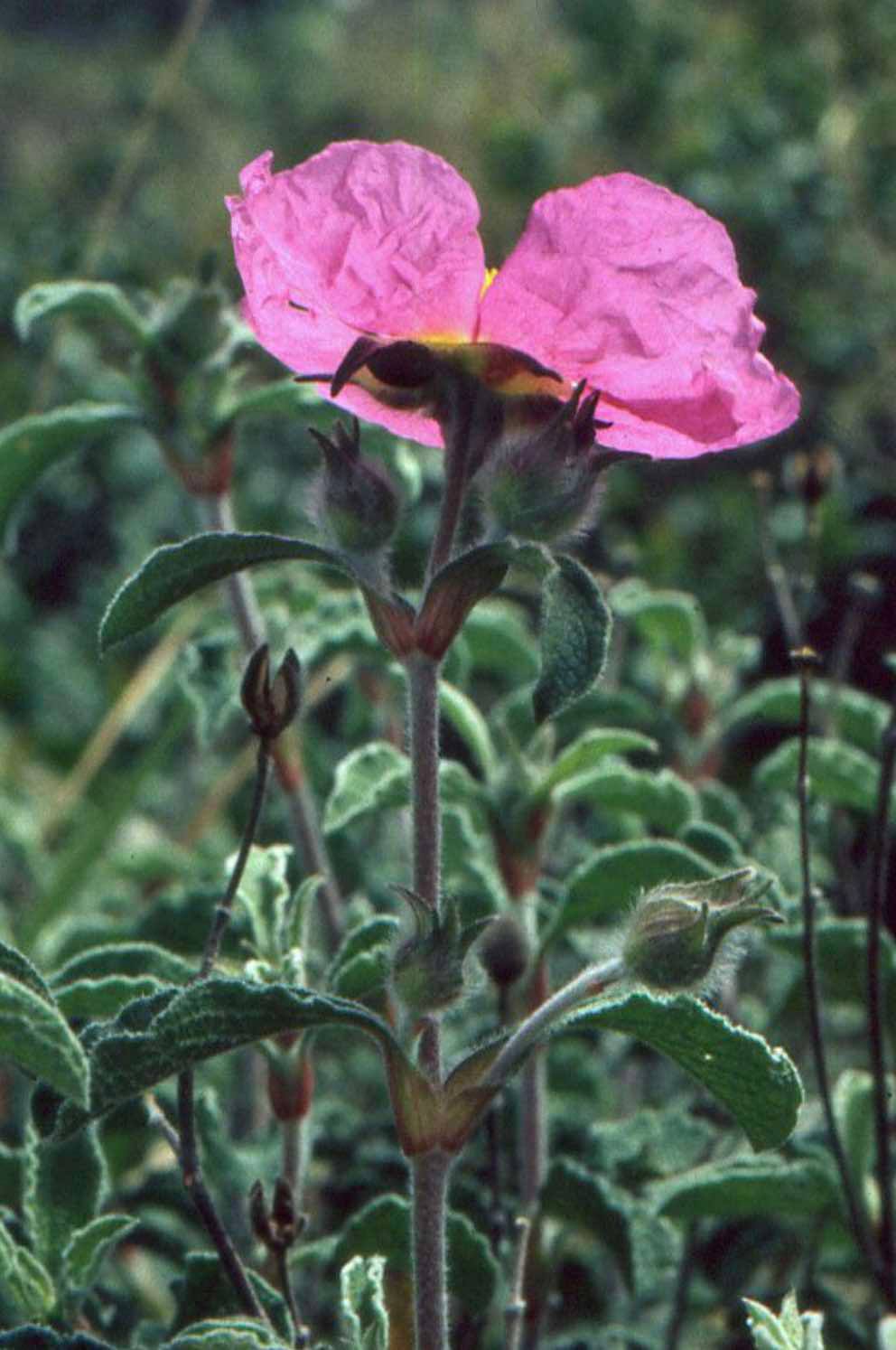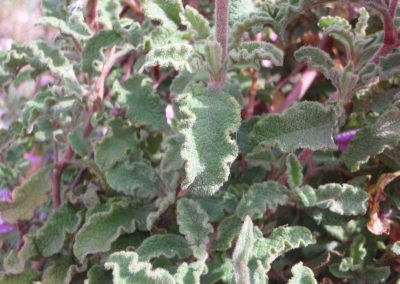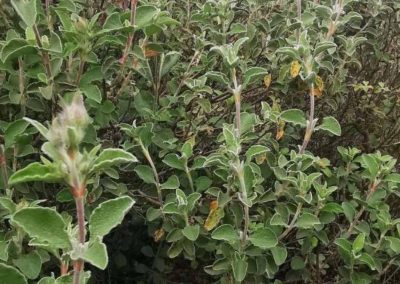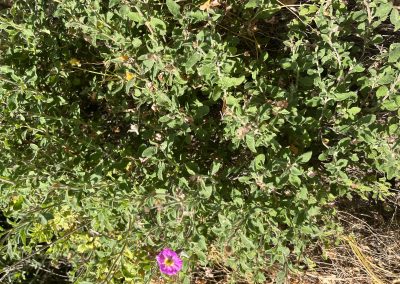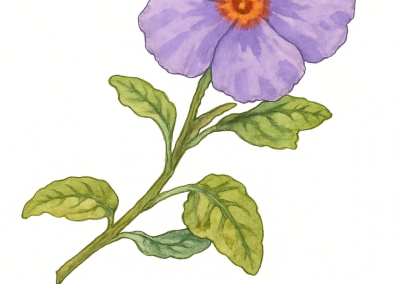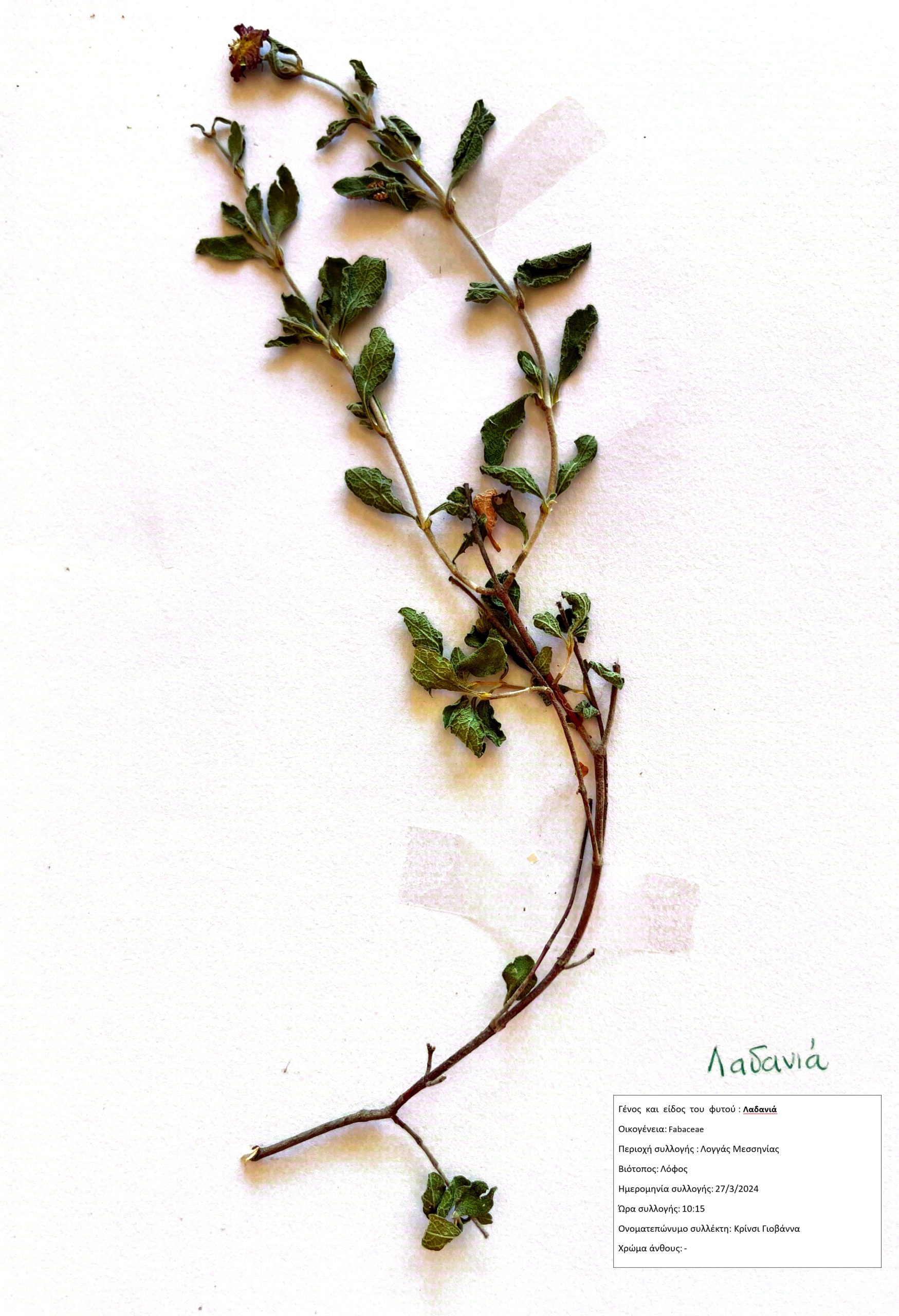Cistus creticus
Scientific description
Scientific name: Cistus creticus L.
Common name: Pink Rock Rose, Cretan Rockrose, Hoary Rockrose
Kingdom: Plantae
Phylum (Division): Tracheophyta
Class: Magnoliopsida
Order: Malvales
Family: Cistaceae
Genus: Cistus
Species: Cistus creticus L.
Origin:
Native to the Mediterranean region — particularly Greece (Crete), Turkey, southern Europe, and North Africa.
Description:
Low-growing evergreen shrub 0.5–1.5 m tall. Aromatic grey-green ovate leaves with softly hairy (tomentose) surface. Large wrinkled pink flowers with bright yellow center, appearing late spring to summer. Flowers last one day but produced profusely. Often confused with Cistus incanus; Cistus creticus is the accepted name.
Propagation:
● By seed: Requires stratification or scarification.
● By cuttings: Semi-hardwood cuttings in late summer root well.
● Self-sowing: Seeds naturally disperse in Mediterranean climates.
Ecology:
● Pollinators: Attracts bees, especially solitary bees.
● Habitat: Poor, rocky, well-drained soils; sunny locations; garrigue, maquis, coastal scrub.
● Adaptations: Drought-tolerant, fire-adapted; resinous leaves aid survival in hot, dry climates.
● Symbiosis: Forms mycorrhizal associations to improve nutrient uptake.
Usage:
Medicine: respiratory, immune, inflammatory conditions; rich in polyphenols and antioxidants. Herbal infusion (rockrose tea) popular for immunity. Cosmetics: extracted resin (labdanum) used in perfumery and skincare.
Επιστημονική ονομασία: Cistus creticus L.
Κοινή ονομασία: Ροζ Πετρολούλουδο, Κρητικό Πετρολούλουδο, Χουάρυ Πετρολούλουδο
Βασίλειο: Plantae
Φύλο (διαίρεση): Τραχειόφυτα
Τάξη: Magnoliopsida
Οικογένεια: Cistaceae
Γένος: Cistus
Είδος: Cistus creticus L.
Καταγωγή:
Μεσογειακή περιοχή — Ελλάδα (ιδίως Κρήτη), Τουρκία, νότια Ευρώπη και Βόρεια Αφρική.
Περιγραφή:
Χαμηλός, αειθαλής θάμνος 0,5–1,5 μ., με αρωματικά γκριζοπράσινα ωοειδή φύλλα, απαλά τριχωτά (tomentose). Μεγάλα ροζ ζαρωμένα άνθη με φωτεινό κίτρινο κέντρο, από τέλη άνοιξης έως καλοκαίρι. Διαρκούν μία ημέρα, αλλά παράγονται άφθονα. Συχνά συγχέεται με Cistus incanus — αποδεκτό όνομα πλέον: Cistus creticus.
Πολλαπλασιασμός:
● Με σπόρο: Απαιτείται στρωμάτωση ή χάραξη.
● Με μοσχεύματα: Ημίσκληρα μοσχεύματα στα τέλη καλοκαιριού ριζώνουν καλά.
● Αυτοσπορά: Σπόροι διασπείρονται φυσικά.
Οικολογία:
● Επικονιαστές: Προσελκύει μέλισσες, ειδικά μοναχικές.
● Βιότοπος: Φτωχά, βραχώδη, καλά στραγγιζόμενα εδάφη, ηλιόλουστες θέσεις, garrigue, maquis, παράκτιοι θαμνώνες.
● Προσαρμογές: Ανθεκτικό στην ξηρασία, προσαρμοσμένο στη φωτιά. Ρητινώδη φύλλα βοηθούν στην επιβίωση.
● Συμβίωση: Μυκορριζικές ενώσεις για καλύτερη απορρόφηση θρεπτικών.
Χρήση:
Ιατρική: αναπνευστικά, ανοσοποιητικά, φλεγμονώδη προβλήματα. Τσάι πετρολούλουδου για ανοσοποιητικές ιδιότητες. Καλλυντικά: ρητίνη (labdanum) σε αρωματοποιία και περιποίηση δέρματος.
Nom scientifique : Cistus creticus L.
Nom commun : Ciste de Crète
Règne : Plantae
Phylum (Division) : Tracheophyta
Classe : Magnoliopsida
Ordre : Malvales
Famille : Cistaceae
Genre : Cistus
Espèce : Cistus creticus L.
Origine :
Région méditerranéenne — Grèce (Crète), Turquie, sud de l’Europe, Afrique du Nord.
Description :
Arbuste à feuilles persistantes 0,5–1,5 m. Feuilles aromatiques gris-vert, légèrement velues (tomenteuses). Grandes fleurs roses ridées avec centre jaune vif, fin printemps à été. Fleurs durent un jour, mais abondantes. Souvent confondu avec Cistus incanus ; Cistus creticus est le nom accepté.
Propagation :
● Par graines : stratification ou scarification.
● Par boutures : bois semi-dur fin été, enracinement facile.
● Auto-ensemencement : dispersion naturelle en climat méditerranéen.
Écologie :
● Pollinisateurs : abeilles, surtout solitaires.
● Habitat : sols pauvres, rocailleux, bien drainés, ensoleillés; garrigue, maquis, littoral.
● Adaptation : tolérant sécheresse, feu ; feuilles résineuses pour climat chaud sec.
● Symbiose : mycorhizes améliorant l’absorption des nutriments.
Utilisation :
Médecine : respiratoire, immunitaire, inflammatoire ; riche en polyphénols et antioxydants. Infusion (thé de ciste) pour immunité. Cosmétique : labdanum pour parfum et soins de la peau.
Denumire științifică: Cistus creticus L.
Denumire comună: Trandafirul de stâncă, Jara stefănească
Regn: Plantae
Încrengătură (Diviziune): Tracheophyta
Clasă: Magnoliopsida
Ordin: Malvales
Familie: Cistaceae
Gen: Cistus
Specie: Cistus creticus L.
Origine:
Regiunea mediteraneană — Grecia (Creta), Turcia, sudul Europei, Africa de Nord.
Descriere:
Arbust veșnic verde, creștere joasă, 0,5–1,5 m. Frunze aromatice gri-verzui, ovate, ușor păroase (tomentoase). Florile mari, ridate, roz, cu centru galben, apar sfârșitul primăverii până vara. Durată o zi, dar abundente. Uneori confundat cu Cistus incanus; Cistus creticus este denumirea acceptată.
Înmulțire:
● Prin semințe: stratificare sau scarificare.
● Prin butași: semi-lemnoși, la sfârșitul verii, prind bine.
● Auto-însămânțare: semințe se dispersează natural.
Ecologie:
● Polenizatori: albine, mai ales solitare.
● Habitat: soluri sărace, stâncoase, bine drenate, însorite; garrigue, maquis, coastă.
● Adaptări: tolerant la secetă și foc; frunze rășinoase pentru climat cald și uscat.
● Simbioză: micoriză pentru absorbția nutrienților în sol sărac.
Utilizare:
Medicină: afecțiuni respiratorii, imune, inflamatorii; bogat în polifenoli și antioxidanți. Infuzie (ceai de stâncă) pentru imunitate. Cosmetică: labdanum pentru parfum și îngrijirea pielii.
Creative writing inspired by Cistus creticus
Cistus creticus — Cistus
According to the legend, the Cistus was once a beautiful young woman named Ladania, the daughter of the goddess Gaia. Ladania had a deep bond with nature, and wherever she walked, plants bloomed, and trees bore rich fruit. The earth loved her so much that it granted her the most precious gifts: the secrets of herbs and plants.
However, Zeus, the king of the gods, saw her and fell in love. Wanting to make her his, he descended to earth to meet her. When Ladania realized his intentions, she sought refuge with her mother, Gaia, begging for protection. Gaia, seeing that she could not prevent Zeus, transformed her daughter into a small, fragrant bush, the Cistus, which would bloom on the rocky hills of Crete.
Zeus, disappointed by the loss of Ladania, accepted her fate and decreed that the plant would forever retain her divine beauty and fragrance. From its leaves would emerge labdanum, a resinous substance with powerful medicinal properties, to be used as incense in temples, honoring her memory.
Thus, the Cistus became a symbol of nature’s harmony, protection, and healing, still carrying the spirit of Ladania, the daughter of the Earth.


